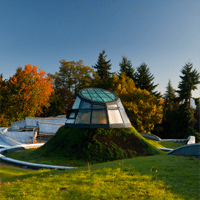Whether you’re building a single-family residence or a giant sports stadium, “low maintenance” is a phrase clients love to hear. What about “no maintenance?” The roof atop the VanDusen Botanical Garden Visitor Centre in Vancouver, British Columbia, is not only beautiful and architecturally stunning, but also completely self-sufficient.
“The roof is designed to simulate the Pacific coastal grassland community; it can essentially survive on its own,” says Ken Larsson, a principal with Sharp & Diamond, the project’s landscape architect. “It uses native bulbs planted among fescue grasses that don’t grow higher than about six inches, and it’s meant to go dormant in the summer. As a result, you don’t have to irrigate, fertilize, or mow.”

Such a roof isn’t easy to make. Its slopes ranged from 5% to 50%, and few systems are designed for such steep angles. This also meant water collected in the valleys, requiring water-tolerant plants.

A landscape miracle? VanDusen’s 19,000-square-foot green roof is ecologically self-sufficient, structurally sound, and eligible for the Living Building Challenge.
The lauded project, planned by the Vancouver Board of Parks and Recreation to be the first Canadian structure to meet the Living Building Challenge, began with a single-story, 19,000-square-foot structure that introduces visitors to the naturalistically planted grounds. To realize the sustainable vision of the board, architect Peter Busby and the team at Perkins+Will designed the visitor center around the aesthetic of an orchid.
It consists of a stem and six petals, evoking the same imagery utilized by the Living Building Challenge itself. The stem, built from rammed-earth walls designed by Sirewall, extends toward the sky. Atop it is a vaulted ceiling and atrium, which infuse the center with natural light. The petals, meanwhile, are formed by the roof, which is constructed of multiple panels and prefab wood-glue laminated beams, made by StructureCraft Builders. Four of those petals are vegetated. One of the two remaining petals, which are covered with standard roofing membrane, holds 400 solar-hot-water tubes from Sunda Solar, and the other, which is inverted, collects water and diverts it into a cistern for reuse.
It’s not a simple system: more than 50 different roof panels enclose the building. A panel averages 15 feet by 65 feet and undulates in multiple directions. The panels were first drawn by the architects using Rhino, then transferred to Revit for working drawings and prefabrication, which incorporated the structure, sheathing, and roofing membrane, as well as rough-ins for fire protection and electrical. “Each panel was brought on flat-bed trucks in segments and individually pieced together like Lego blocks,” Larsson says. “It was very complicated.”
The difficulties didn’t stop there. Making the roof function like a living thing was unusually complex because its topography features slopes ranging from 5 percent to 50 percent. “There aren’t a lot of products on the market that allow you to collect rainwater or grow on rooftops with slopes that steep,” Larsson says. “At the same time, we had to ensure that too much water wasn’t collected. Planting types were adapted to suit water saturation in the valleys.”
Ultimately, green roof consultants Architek and ZinCo Canada worked together with Sharp & Diamond and Cornelia Hahn Oberlander to select a green roof system—together with membrane protection and slope stabilization—that would achieve the designers’ goals—and meet the Roofing Contractors Association of British Columbia warranty—while not violating the red list in the Living Building Challenge, which prohibits toxic materials or PVC products in any building supplies.
The roof, of course, isn’t the only green thing about the visitor center. For one thing, it’s net zero in terms of water and energy. The building’s solar system stores the sun’s heat in water tubes that heat the hydronic fluid in the center’s
radiant heating system. The rest is stored at about 68 degrees Fahrenheit in a series of 52 boreholes, each 200 feet deep, placed in a random pattern around the building. The center exchanges excess hot water for electricity generated in a newly upgraded HVAC system housed in a connecting building. Photovoltaic panels, located in the visitor center’s parking lot, provide an additional 11 kilowatts of electricity, which is actually about 20–25 percent of the center’s electrical energy requirements, thanks to daylighting and LED light fixtures from Selux, Alights, Philips Ledalite, and Douglas Lighting Controls.
“It was a truly collaborative design process, with all disciplines, contractors, and suppliers working together to solve problems of a technical nature in a very tight time frame,” Larsson says. “North Americans are used to typically seeing green and lush landscapes. When clients see a site or living roof going brown and scruffy they think something is wrong, but that actually means it is working. We want to connect people to a healthier way of building and design. We believe we have seamlessly blended architecture, landscape, and ecology.”

